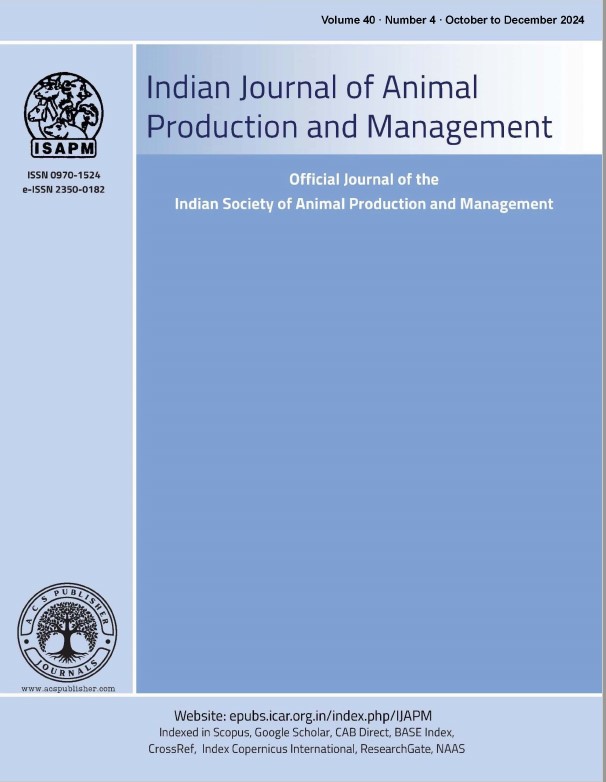Behavioural Time Allocation in Suckled Buffaloes: Analysis of Pre- and Post-Estrus Periods
DOI:
https://doi.org/10.48165/ijapm.2024.40.SI.7Keywords:
bull biostimulation, direct contact, fenceline contact, estrous, time budgetAbstract
This study aims to investigate time spent on eating, rumination, and resting during the three days before, the day of, and three days after, estrus in suckled buffaloes. Two experiments were conducted with 24 buffaloes each. In Experiment 1, buffaloes were divided into three groups (n=8): NC (No Cow-Calf and Cow-Bull Contact), RC (Restricted Cow-Calf and Fenceline Cow-Bull Contact), and FC (Fenceline Cow-Calf and Cow Bull Contact). In Experiment 2 (n=12), buffaloes were divided into two groups: RC (Restricted Cow Calf and No Cow-Bull Contact) and FC (Fenceline Cow-Calf and Direct Cow-Bull Contact). The data on mean frequencies of the time spent on eating, rumination and resting behaviours were compared between treatments on 3 days before oestrus (d -3, -2, -1), the day of oestrus (d 0) and 3 days after oestrus (d +1, +2, +3), using Duncan’s Multiple Range test and a one-way ANOVA. There was a significant effect of time (P<0.01), group (P<0.01), and their interaction (P<0.01) on time spent on eating, rumination, and resting in both experiments. In Experiment 1, the mean time spent on feeding was significantly higher (P<0.05) in the FC group compared to RC and NC on day -2 of estrus. Time spent on rumination was significantly higher (P<0.05) in RC and FC groups compared to NC on days -2, -1, and +1 of estrus. Resting time was statistically similar among the three groups on the day of estrus. In Experiment 2, resting time was significantly different (P<0.01) between RC and FC groups on days -2, -1, and +2 of estrus, but not on days -3, 0, +1, and +3. In conclusion, changes in feeding, rumination, and resting behaviors are significant indicators for detecting estrus in buffaloes. Fenceline and direct contact with bulls enhance these behavioral changes, providing a practical approach to estrus detection through monitoring of these specific activities.
References
Allrich, R. D. (1994). Endocrine and Neural Control of Estrus in Dairy Cows. Journal of Dairy Science, 77(9), 2738–2744. https://doi.org/10.3168/jds.S0022-
0302(94)77216-7
Chenoweth, P. J. (1983). Sexual Behavior of the Bull: A Review. Journal of Dairy Science, 66(1), 173–179. https://doi.org/10.3168/jds.S0022- 0302(83)81770-6.
Choudhary, S., and Lal Kamboj, M. (2019). Effect of bull biostimulation on the oestrous behaviour of pubertal Sahiwal (Bos indicus) heifers. Animal Reproduction Science, 209(August), 106149. https://doi.org/10.1016/j.anireprosci.2019.1061
49
Choudhary, S., Kamboj, M. L., Ungerfeld, R., and Singh, P. (2022). Calf‐cow and bull‐cow management in buffaloes: Effects on growth, productive and reproductive performance of mothers and their calves. Reproduction in Domestic Animals, 57(11), 1428-1439
Dolecheck, K. A., Silvia, W. J., Heersche, G., Chang, Y. M., Ray, D. L., Stone, A. E., Bewley, J. M. (2015). Behavioral and physiological changes around estrus events identified using multiple automated monitoring technologies. Journal of Dairy Science, 98(12), 8723–8731. https://doi.org/10.3168/jds.2015-9645
Firk, R., Stamer, E., Junge, W. and Krieter, J. (2002). Automation of oestrus detection in dairy cows: A review. Livestock Production Science, 75(3), 219–232
ICAR, (2013). Nutrient requirement of cattle and buffaloes. Nutrient requirement of animals. Indian Council of Agricultural Research, New
Delhi.
Ingvartsen, K. L. and Andersen, J. B. (2000). Symposium: Dry matter intake of lactating dairy cattle. J. Dairy Sci, 83, 1573-1597
López-Gatius, F., Santolaria, P., Mundet, I. and Yániz, J. L. (2005). Walking activity at estrus and subsequent fertility in dairy cows. Theriogenology, 63(5), 1419–1429
Mat, K. B., Rusli, N. D., Mohd, B. M., and Hasnita, C. H. (2014). The potency of bull exposure in improving reproductive performance in dairy cows. Journal of Applied Science and Agriculture, 9(15), 36-42.
Kerbrat, S. and Disenhaus, C. (2004). A proposition for an updated behavioural characterisation of the oestrus period in dairy cows. Applied Animal Behaviour Science, 87(3–4), 223–238
Rajput, M. S. and Kamboj, M.L. (2019). Effect of biostimulation on the sexual behaviour and reproductive performance of Sahiwal cows (Doctoral dissertation, ICAR - National Dairy Research Institute, Karnal). https://krishikosh.egranth.ac.in/handle/1/58101
63098.
Reith, S. and Hoy, S. (2012). Relationship between daily rumination time and estrus of dairy cows. Journal of Dairy Science, 95(11), 6416–6420. https://doi.org/10.3168/jds.2012-5316.
Roelofs, J. B., Van Eerdenburg, F. J. C. M., Soede, N. M. and Kemp, B. (2005). Various behavioral signs of estrous and their relationship with time of ovulation in dairy cattle. Theriogenology, 63(5), 1366–1377. https://doi.org/10.1016/j.theriogenology.2004.0
7.009
Pahl, C., Hartung, E., Mahlkow-Nerge, K. and Haeussermann, A. (2015). Feeding characteristics and rumination time of dairy cows around estrus. Journal of Dairy Science, 98(1), 148–154. https://doi.org/10.3168/jds.2014-
8025.
Sveberg, G., Refsdal, A. O., Erhard, H. W., Kommisrud, E., Aldrin, M., Tvete, I. F. and Ropstad, E. (2011). Behavior of lactating Holstein-Friesian cows during spontaneous cycles of estrus. Journal of Dairy Science, 94(3), 1289–1301. https://doi.org/10.3168/jds.2010-
3570
Usmani, R. H. and Keith Inskeep, E. (1989). Effect of prepartum feeding on milk yield and calf growth rate in limited-suckled and non-suckled buffaloes. Journal of Dairy Science, 72(8), 2087–2094. https://doi.org/10.3168/jds.S0022-
0302(89)79333-4
Van Vliet, J. H. and Van Eerdenburg, F. J. C. M. (1996). Sexual activities and oestrus detection in lactating Holstein cows. Applied Animal Behaviour Science, 50(1), 57–69
Verma, K. K., Prasad, S., Mohanty, T. K., Kumaresan, A., Layek, S. S., Patbandha, T. K., and Kantwa, S. C. (2014). Behavioural signs of estrus in different parity of Murrah buffaloes (Bubalus bubalis): A comparative study. Indian Journal of Animal Research, 48(6), 620–624
Zebari, H. M., Rutter, S. M. and Bleach, E. C. L. (2018). Characterizing changes in activity and feeding behaviour of lactating dairy cows during behavioural and silent oestrus. Applied Animal Behaviour Science, 206(June), 12–17.

